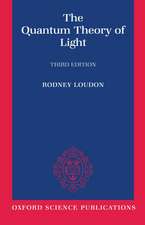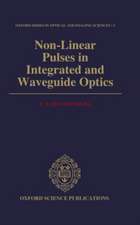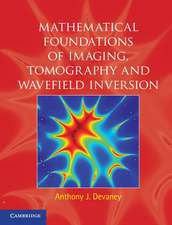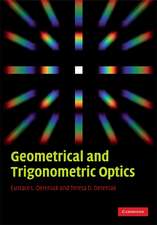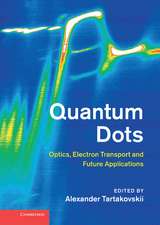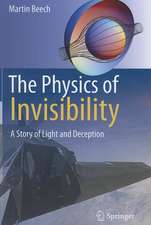Nonlinear Optics, Quantum Optics, and Ultrafast Phenomena with X-Rays: Physics with X-Ray Free-Electron Lasers
Editat de Bernhard Adamsen Limba Engleză Paperback – 18 apr 2013
It is intended for the use by scientists at synchrotron radiation facilities working with the combination of x-rays and lasers and those preparing for the science at x-ray free-electron lasers. In the past decade synchrotron radiation sources have experienced a tremendous increase in their brilliance and other figures of merit.
This progress, driven strongly by the scientific applications, is still going on and may actually be accelerating with the advent of x-ray free-electron lasers. As a result, a confluence of x-ray and laser physics is taking place, due to the increasing importance of laser concepts, such as coherence and nonlinear optics to the x-ray community and the importance of x-ray optics to the laser-generation of ultrashort pulses of x-rays.
| Toate formatele și edițiile | Preț | Express |
|---|---|---|
| Paperback (1) | 947.35 lei 6-8 săpt. | |
| Springer Us – 18 apr 2013 | 947.35 lei 6-8 săpt. | |
| Hardback (1) | 956.03 lei 6-8 săpt. | |
| Springer Us – 30 aug 2003 | 956.03 lei 6-8 săpt. |
Preț: 947.35 lei
Preț vechi: 1155.30 lei
-18% Nou
Puncte Express: 1421
Preț estimativ în valută:
181.30€ • 187.29$ • 150.89£
181.30€ • 187.29$ • 150.89£
Carte tipărită la comandă
Livrare economică 25 martie-08 aprilie
Preluare comenzi: 021 569.72.76
Specificații
ISBN-13: 9781461350514
ISBN-10: 1461350514
Pagini: 356
Ilustrații: XXIII, 330 p.
Dimensiuni: 155 x 235 x 19 mm
Greutate: 0.5 kg
Ediția:Softcover reprint of the original 1st ed. 2003
Editura: Springer Us
Colecția Springer
Locul publicării:New York, NY, United States
ISBN-10: 1461350514
Pagini: 356
Ilustrații: XXIII, 330 p.
Dimensiuni: 155 x 235 x 19 mm
Greutate: 0.5 kg
Ediția:Softcover reprint of the original 1st ed. 2003
Editura: Springer Us
Colecția Springer
Locul publicării:New York, NY, United States
Public țintă
ResearchDescriere
Nonlinear Optics, Quantum Optics, and Ultrafast Phenomena with X-Rays is an introduction to cutting-edge science that is beginning to emerge on state-of-the-art synchrotron radiation facilities and will come to flourish with the x-ray free-electron lasers currently being planned.
It is intended for the use by scientists at synchrotron radiation facilities working with the combination of x-rays and lasers and those preparing for the science at x-ray free-electron lasers. In the past decade synchrotron radiation sources have experienced a tremendous increase in their brilliance and other figures of merit.
This progress, driven strongly by the scientific applications, is still going on and may actually be accelerating with the advent of x-ray free-electron lasers. As a result, a confluence of x-ray and laser physics is taking place, due to the increasing importance of laser concepts, such as coherence and nonlinear optics to the x-ray community and the importance of x-ray optics to the laser-generation of ultrashort pulses of x-rays.
It is intended for the use by scientists at synchrotron radiation facilities working with the combination of x-rays and lasers and those preparing for the science at x-ray free-electron lasers. In the past decade synchrotron radiation sources have experienced a tremendous increase in their brilliance and other figures of merit.
This progress, driven strongly by the scientific applications, is still going on and may actually be accelerating with the advent of x-ray free-electron lasers. As a result, a confluence of x-ray and laser physics is taking place, due to the increasing importance of laser concepts, such as coherence and nonlinear optics to the x-ray community and the importance of x-ray optics to the laser-generation of ultrashort pulses of x-rays.
Cuprins
1 X-Ray Sources.- 1 Introduction.- 2 X-Ray Tubes.- 3 Laser-Driven Sources.- 4 Synchrotrons and Storage Rings.- 5 Pulse Slicing and Ultrafast Thomson Scattering.- 6 Energy-Recovering Linacs.- 7 X-Ray Free-Electron Lasers.- 7.1 The Physics of the FEL Process.- 7.2 Hard X-Ray FEL Facilities in Planning.- 7.3 The Quantum FEL.- 7.4 Lasing without Inversion.- 8 Comparison of Sources.- 2 Nonlinear Optics of Free Electrons.- 1 Introduction.- 2 Relativistic Electrons in Electromagnetic Waves.- 2.1 Single Plane Wave Packet.- 2.2 Multiple Parallel Plane Waves.- 2.3 Multiple Plane Waves, Nonrelativistic Approximation.- 2.4 Relativistic Electrons in Two Plane Wave Packets.- 2.4.1 Discussion.- 2.5 Laser Acceleration of Electrons.- 3 Dynamical Diffraction.- 1 Introduction.- 2 Linear Perfect Crystal Theory.- 2.1 Perfect Lattice, Fourier and Bloch Sums.- 2.2 The System of Linear Equations.- 2.3 The Dispersion Surface.- 2.4 Phase and Group Velocity, Beam Direction.- 2.5 Extinction and Boundary Conditions.- 3 Extended Takagi-Taupin Theory.- 3.1 Disturbed Lattice, Fourier and Bloch Sums.- 3.2 The System of Differential Equations.- 3.3 Comparison with the Takagi-Taupin Theory.- 3.3.1 Differential Equations.- 3.3.2 Generalized Wave Fields.- 3.4 Comparison with Kato's Eikonal Theory.- 3.5 Numerical Solution of the Differential Equations.- 3.6 The Dispersion Surface.- 3.6.1 Propagation of the Field Amplitudes.- 3.7 Beams, Adiabatic Change and Interbranch Scattering.- 3.8 Obtaining Qualitative Information.- 3.8.1 Example: Optical Phonons, Frequency Shifts.- 3.8.2 Example: Static Distortion, Guided Waves.- 3.9 From Boundary to Transition Conditions.- 3.10 Summary and Discussion.- 4 Nonlinear Dynamical Diffraction from Free Electrons.- 4.1 Multiple Bloch Waves.- 4.2 The System of Nonlinear Equations.- 4.3 An Example: Parametric Down Conversion.- 5 Appendix.- 5.1 Dynamical Diffraction in Macroscopic Form.- 5.2 The Longitudinal Current.- 5.3 Applicability of Macroscopic Electromagnetism.- 5.4 The Position of a Tie Point in Reciprocal Space.- 5.5 The Direction of the Poynting Vector.- 5.6 Details of Derivations.- 5.6.1 Amplitude Ratio, Equation (3.15).- 5.6.2 Equation (3.27).- 5.6.3 An Integral.- 4 Ultrafast Diffractive X-Ray Optics.- 1 Introduction.- 2 Laser-Induced Changes in Crystal Diffractive Properties.- 3 Bragg Reflection.- 4 Laue Transmission.- 4.1 Redirection of the Poynting Vector.- 4.2 An X-Ray Optical Femtosecond Streak Camera.- 4.2.1 Grazing Incidence.- 4.2.2 Swept Laser Excitation.- 4.2.3 An Example.- 4.2.4 Discussion.- 4.3 An Ultrafast Phase Retarder.- 4.4 Spectral Concentration of X-Rays.- 4.5 A Fast Borrmann Shutter.- 5 Parametric Down Converion.- 1 Introduction.- 1.1 Nonlinear Medium.- 1.2 Wave Vector and Frequency Matching.- 1.3 Strength of the Effect.- 2 Experiments.- 2.1 The Classical Experiment by Eisenberger and McCall.- 2.2 The First Synchrotron Results, Yoda et al.- 2.3 Energy Discrimination and Time Correlation.- 2.4 High Event Rate.- 2.5 High Pump Photon Energy - 98.9 keV.- 2.6 Suppression of the Pump Photons with a Mirror.- 2.7 Small Angles.- 2.7.1 The First Small-Angle Experiment.- 2.7.2 APS, 1-ID.- 2.7.3 APS, 7-ID.- 2.7.4 Suppression of Down Conversion at Small Angles.- 2.8 Wave Vector Matching by Dynamical Diffraction.- 3 Potential Applications.- 3.1 Tests of the Quantum Theory.- 3.2 Sub-Poisson Absorption Spectroscopy.- 3.3 Integration into a Beam Line.- 4 Experimental Issues.- 4.1 Background Suppression.- 4.2 Electric Noise.- 4.3 Stray Radiation.- 4.4 Energy Resolution.- 4.5 Time Resolution.- 4.6 Time Structure of the Source.- 4.7 Choice of Sample Material.- 5 Summary.- 6 Appendix.- 6.1 The Virtual Power Density of Vacuum Fluctuations.- 6.2 Cross Section.- 6.3 Amplitude Growth.- 6.4 Wave Vector Matching.- 6.4.1 Without Dynamical Diffraction.- 6.4.2 With Dynamical Diffraction of the Pump Only.- 6.5 Electronics.- 6.5.1 The Correlation Circuit.- 6.5.2 The Event Logger.- 6 Laser Pump, X-Ray Probe Spectroscopy on GaAs.- 1 Introduction.- 2 Physics Background.- 3 The Experiment.- 4 Results.- 5 Discussion.- 6 Experimental Issues.- 6.1 Monochromatization.- 6.2 Electronic Noise.- 7 Potential Applications.- 7.1 Spectroscopy with an Absolute Energy Reference.- 7.2 A Femtosecond Detector and X-Ray/Laser Correlator.- 7 Ultrafast structural changes induced by femtosecond laser pulses.- 1 Introduction.- 2 Theory.- 2.1 Lattice motion: molecular dynamics simulations.- 2.2 Potential energy surface: laser induced electron dynamics.- 2.2.1 Summary of the numerical approach.- 2.2.2 Pair correlation function.- 3 Ultrafast nonequilibrium graphitization of diamond.- 4 Ablation mechanisms in graphite.- 5 Nonequilibrium melting and ablation of carbon.- 6 Ablation of silicon.- 7 Laserinduced melting of a C60 molecular crystal.- 8 Fragmentation of nanotubes.- 9 Summary.- 8 Ultrafast Lattice Dynamics.- 1 Introduction.- 2 Experimental Setup.- 2.1 The Advanced Light Source.- 2.2 X-ray Time-Structure.- 2.3 Laser Synchronization.- 2.4 Streak Camera.- 3 Theory of Time-Resolved X-Ray Diffraction.- 4 Wave-vector Matching Considerations.- 4.1 Symmetric Case.- 5 Generation of coherent displacements.- 6 Extension to Finite Electron-Phonon Coupling Times.- 7 Experimental Results.- 7.1 Slow (Nanosecond) Time-scale Measurements.- 7.2 50 ps Resolution Pump-Probe Experiments.- 7.3 Streak Camera Results.- 8 Extraction of Electron-Phonon Coupling Times.- 9 High Fluence Results.- 10 Coherent Control.- 10.1 Introduction.- 10.2 Experimental Results.- 11 Control of the Diffraction Efficiency of a Crystal.- 12 Conclusion.- 9 Seeing Sound: Measuring acoustic pulse propagation with x-rays.- 1 Introduction.- 2 Ultrafast Strain Generation.- 2.1 Thermo-elastic model.- 2.2 Plasma Diffusion.- 3 The X-ray Source.- 3.1 Bunch Timing.- 4 Ultrafast Laser.- 4.1 T:sapphire oscillator.- 4.2 Chirped Pulse Amplification.- 4.3 Laser/X-ray Timing.- 5 Time-resolved x-ray Bragg diffraction.- 5.1 Dynamical diffraction calculations.- 5.2 Acoustic Pulse Evolution.- 5.3 Acoustic Reflections.- 5.3.1 Acoustic Dispersion.- 6 Time-resolved Laue diffraction.- 6.1 Pump-Probe X-ray Anomalous Transmission.- 6.2 Multiple crystal model.- 6.3 Acoustic Reflections.- 6.4 Acoustic Collisions.- 7 Summary and Acknowledgements.- 10 Time-dependent dynamical diffraction theory for phonon-type distortions.- 1 Introduction.- 2 The generalised Takagi-Taupin equation.- 3 Comparison with classical Takagi-Taupin theory.- 4 Coherent phonons and selection rules.- 5 Perturbative analytical solution.- 6 Numerical solution of the generalised Takagi-Taupin equation.- 7 High spatial frequency phonons.- 11 Nonlinear Response Functions for X-Ray Laser Pulses.- 1 Introduction.- 2 Nonlinear response functions: general formalism.- 3 Applications.- 4 Event rates and cross sections.- 5 Conclusions.- 6 Acknowledgments.- 7 Appendix.- References.

